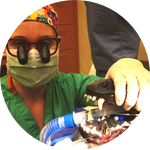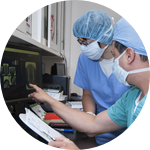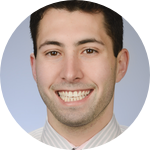Project Results
Maxillae and/or mandibles from 76 walruses (Odobenus rosmarus) were examined macroscopically according to predefined criteria. The museum specimens were acquired between 1932 and 2014. Forty-five specimens (59.2%) were from male animals, 29 (38.2%) from female animals and two (2.6%) from animals of unknown sex, with 58 adults (76.3%) and 18 young adults (23.7%) included in this study. The number of teeth available for examination was 830 (33.6%); 18.5% of teeth were absent artefactually, 3.3% were deemed to be absent due to acquired tooth loss and 44.5% were absent congenitally. The theoretical complete dental formula was confirmed to be I 3/3, C 1/1, P 4/3, M 2/2, while the most probable dental formula is I 1/0, C 1/1, P 3/3, M 0/0; none of the specimens in this study possessed a full complement of theoretically possible teeth. The majority of teeth were normal in morphology; only five teeth (0.6% of available teeth) were malformed. Only one tooth had an aberrant number of roots and only one supernumerary tooth was encountered. No persistent deciduous teeth were found in any of the young adult or adult specimens, nor were any specimens affected by enamel hypoplasia. The majority of teeth (85.5%) displayed attrition/abrasion. Of the adult and young adult specimens, 90.8% showed some degree of attrition/abrasion on at least one tooth. Tooth fractures were noted in eight walruses, affecting 10.5% of specimens and 1.3% of the total number of teeth, nearly three-quarters of which were maxillary canine teeth (tusks). Three specimens (3.9%), all adult males, displayed overt periapical disease. The majority (99.2%) of dental alveoli did not have bony changes indicative of periodontitis, with only five specimens (6.6%) affected by periodontitis. Lesions consistent with temporomandibular joint osteoarthritis (TMJ-OA) were found in 46 specimens (60.5%) and TMJ-OA was significantly more common in adults than young adults and males than females. Although the clinical significance of dental and TMJ pathology in the walrus remains unknown, the occurrence and severity of these lesions may play an important role in the morbidity and mortality of this species.
Dental and Temporomandibular Joint Pathology of the Walrus (Odobenus rosmarus)
J.N.Winer, B. Arzi, D.M.Leale, P.H.Kass, and F.J.M. Verstraete
About This Project
Tooth and jaw (temporomandibular) joint (TMJ) diseases are common in certain wildlife species and may be important contributors to morbidity (sickness) and mortality (death). Our group has documented the dental and TMJ pathology of the elephant seal, southern sea otter, California sea lion, northern fur seal and the harbor seal. The aim of this study is to determine the nature and prevalence of dental and TMJ pathology in the walrus by examining skull specimens at the University of Alaska.
Ask the Scientists
Join The DiscussionWhat is the context of this research?
Studying teeth can provide insights into the natural history of a species, including a better understanding of feeding, behavior, diseases, and causes of death. For example, a spike in congenital tooth or jaw defects can potentially signal a bottleneck with inbreeding. Our group has previously documented the dental pathology of the northern elephant seal, the southern sea otter, the California sea lion, the northern fur seal and the Eastern Pacific harbor seal. In addition, we have characterized the structure of the temporomandibular joint (TMJ) in the southern sea otter and the California sea lion. We have also described the pathology of the TMJ in the southern sea otter, the California sea lion, the northern fur seal and the Eastern Pacific harbor seal.
What is the significance of this project?
Our research has shown that there are many similarities in the dental pathology of marine mammals but also several species-specific conditions. For example, many sea otters suffer from severe tooth abrasion (abnormal wear) while many California sea lions have osteoarthritis of the TMJ. In many instances, these conditions are likely to have caused considerable morbidity and may have contributed to mortality by causing pain associated with eating and thus decreased ability to forage and consume food. The walrus is a data deficient species, meaning that there is insufficient information for a proper assessment of conservation status. There is no information on the dental and TMJ pathology of the walrus, hence the importance of investigating this important part of their overall health status.
What are the goals of the project?
The aim of this study is to determine the nature and prevalence of dental and TMJ pathology in the walrus by examining walrus skulls at the University of Alaska in Fairbanks. Present teeth and surrounding bony tissue will be inspected systematically according to predefined criteria utilized in former studies. The TMJs will be inspected using a descriptive and repeatable scoring system also previously published. Data from all skulls will be pooled according to tooth type and analyzed with descriptive statistics. Once we have collected this data, we will discuss how tooth and jaw diseases could have impacted the health and lives of these walrus specimens, and how dental and TMJ disease could impact the species as a whole.
Budget
The budget includes the airfare (Sacramento, CA - Fairbanks, AK), rental car and accommodation of two faculty, one graduate student and one research assistant. The University of Alaska in Fairbanks has the largest collection of walrus skulls, which is why the travel budget is essential for the completion of the project. We have no external funding for this study.
Endorsed by
Meet the Team
Affiliates
Affiliates
Affiliates
Affiliates
Team Bio
The team consists of Frank Verstraete, Boaz Arzi, Jenna Winer and Dustin Leale. All have extensive experience in studies involving the inspection of marine mammal skulls and teeth. Frank Verstraete focuses on the dental pathology while Boaz Arzi's main interest is the temporomandibular joint.
Frank J.M. Verstraete
I am a Professor of Dentistry and Oral Surgery at the School of Veterinary Medicine. My clinical activities range from preventative dentistry to major oral surgery in dogs and cats, as well as pet rabbits and rodents, and occasionally zoo animals. I have a keen research interest in the comparative aspects of oral diseases. This is exemplified by my research on the dental and temporomandibular joint pathology in marine mammals, which was recently featured at the California Academy of Sciences in San Francisco.
Boaz Arzi
I am an Assistant Professor of Dentistry and Oral Surgery at the Department of Surgical and Radiological Sciences. I completed the residency training program in Dentistry and Oral Surgery at the Veterinary Medical Teaching Hospital, University of California - Davis. I am a Diplomate of the American and European Veterinary Dental Colleges. I completed a post-doctoral fellowship at the Department of Biomedical Engineering, working on bioengineered fibrocartilage spectrums such as the TMJ and their surgical applications. I have a deep interest in TMJ research in animals and man and have conducted multiple studies on the TMJ in marine and terrestrial mammals.
Jenna Winer
I am a Resident currently specializing in dentistry and oral surgery at the UC Davis School of Veterinary Medicine. I developed an interest in veterinary dentistry when I completed research on sea otter dental pathology. I also have an interest in the One Health movement and enjoy discussing cases with my father, who practices dentistry on people. My special interests include dentistry of wildlife and zoo species, and maxillofacial surgery.
Dustin Leale
I am a junior specialist managing the Arzi lab in the Department of Surgical and Radiological Sciences. I have experience with the biochemical, mechanical, and microscopic imaging of the TMJ tissues. I have helped study the TMJ of several marine mammal species, as well as trained veterinary students at UC Davis in the laboratory analysis of joint tissues.
Project Backers
- 13Backers
- 100%Funded
- $5,718Total Donations
- $63.08Average Donation
















